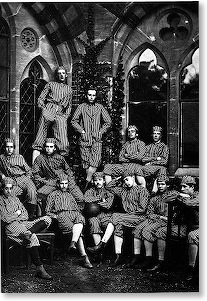First Rules
 Many of the boys at
the public schools went on to the two English
universities, Oxford and Cambridge. Football was
very popular at Cambridge, but the young men from
the different schools played with different rules.
Many of the boys at
the public schools went on to the two English
universities, Oxford and Cambridge. Football was
very popular at Cambridge, but the young men from
the different schools played with different rules.
Cambridge Rules
In 1848 a set of Cambridge
Rules were established for everyone to play under. Some
of these rules now seem a little strange.
- After
every goal the teams changed ends.
◦ A player could also catch the ball if it came directly from another player's foot.
◦ If the ball came past a player from the direction of his own goal he had to wait until an opponent touched it.
- the idea of the ‘foul’ and ‘foul play’.
- The other was that the ball was only ‘in play’ on the pitch itself.
Sheffield Rules
In the late 1850s the first
football clubs were started. Sheffield FC was the first
club that was not a school or a university. It was
formed in 1857, and its own rules. These were similar
to the Cambridge rules.
- Pushing
with the hands was allowed, but not kicking or
tripping.
◦ Running with the ball in the hands was not allowed.
◦ The ball could be caught if it had not touched the ground.
◦ The ball could also be pushed on with the hand.
◦ No offside rules. Players known as "'kick-throughs'" were positioned permanently in the opponents' half.
◦ No limit on the number of players, or the size and shape of ball.
◦ No referees. The two captains settled any dispute.
-
Not yet soccer
-
It is very difficult to head the ball if you are wearing a hat!